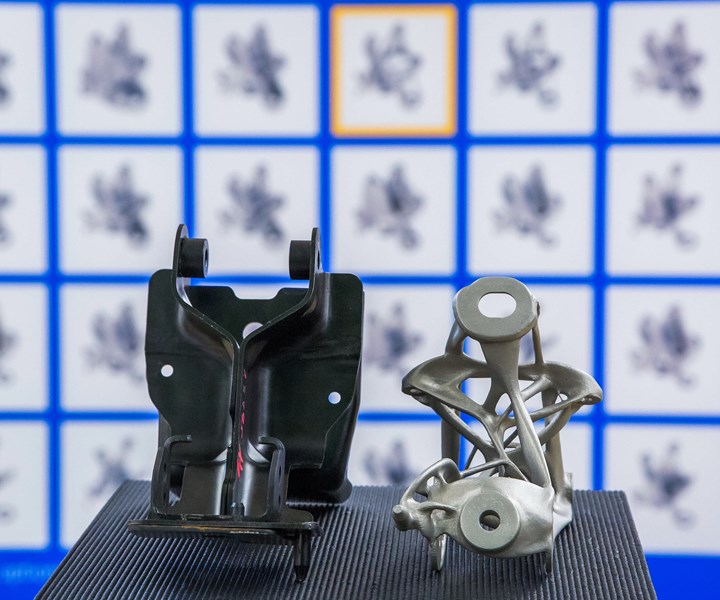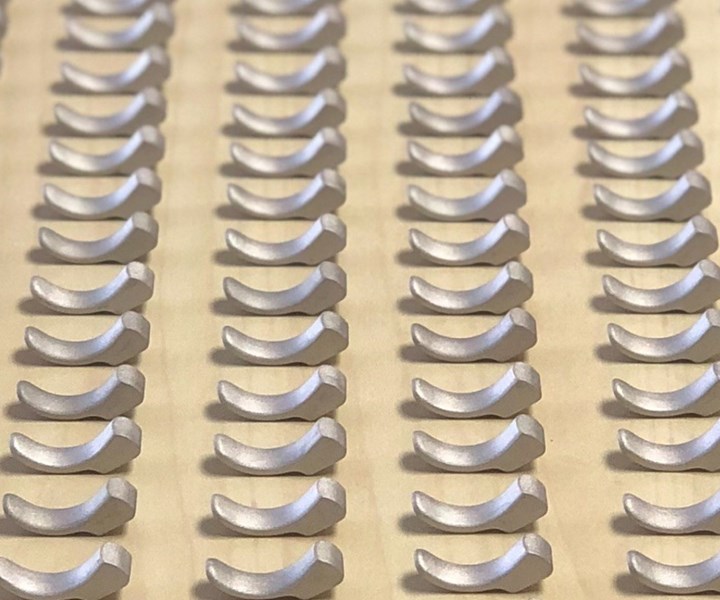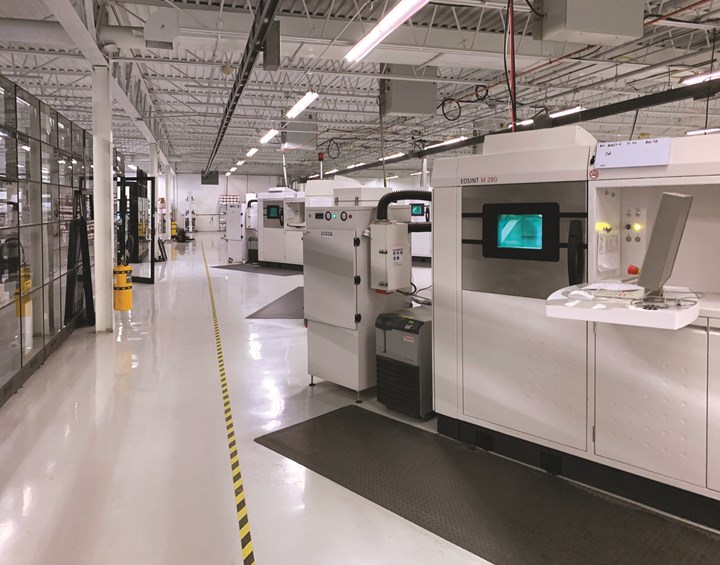During the past few years, Production Machining has been introducing coverage of additive manufacturing because we saw its potential to support production machine shops. During that time, its use has grown significantly, both in general manufacturing and in our readers’ shops.
Initially for our audience, additive seemed more of a novelty. After years of removing material for a final product, it was a significant adjustment to think about building components from metal powder or extruded plastic. But its advantages have encouraged us to adjust our approach. Additive found its way into prototyping for more and more applications until we started to wonder if it had potential for full production of parts.
Today, additive is starting to establish itself as an accepted production process. PM's sister brand, Additive Manufacturing, has spent the last year uncovering where additive is being used for full production, and the changes shops and suppliers have made to reach that point. Here are a few of the applications that hit closest to home for us.
Design and Workflow for Production Additive

Generative design software can help car makers design stronger, lighter and cheaper parts for electric vehicles, many of which must be produced via additive manufacturing. The seat bracket on the right, which was made with generative design software and AM, is 40% lighter and 20% stronger than the original assembly on the left.
The manufacturing industry’s shift from subtractive to additive manufacturing coincides with the automotive industry’s shift from internal combustion engines to electricity. This is partially because the development of a new type of vehicle provides an opportunity for a new approach to manufacturing. This new type of vehicle will also require different parts—ones that are cheaper and lighter. Generative design technology, such as Autodesk’s Fusion 360, can design parts to meet these requirements, many of which can only be produced via AM. For example, GM and Autodesk designed and produced a 3D-printed seat bracket that’s 40% lighter and 20% stronger than the original assembly. To further explore the possibilities of producing stronger, lighter and cheaper parts with generative design and AM, the two companies formalized a partnership earlier this year.
GM and Autodesk are at the beginning stages of bringing generatively designed and additively manufactured parts to the automotive industry. While working on this, they realized they must rethink workflow to produce these parts on a large scale. According to one Autodesk engineer, even if additive machines could handle the volumes the automotive industry requires, engineers would struggle to break their workflow routine habits. Now GM and Autodesk are tackling the challenge of creating a process for designing a CAD model, producing the setup for additive manufacturing and converting the model to import it into simulation.
Read “Why GM’s Electric Future is Also an Additive Future” (gbm.media/amev) to explore the connections between additive manufacturing and electric vehicles.
Machines Designed for Production Metal AM

Companies are also developing additive manufacturing systems that can compete with conventional machining methods. 3DEO’s system is designed to achieve scalable, cost efficient, rapid metal AM for series of small parts.
In addition to producing parts that cannot be made any other way, additive is advancing to efficiently produce parts that can be made by traditional methods. In other words, AM doesn’t just complement conventional methods—it competes with them. The key to being competitive in this space is price, so companies are working to achieve scalable, cost efficient, rapid metal AM.
To reach this goal, 3DEO has developed its own additive technology, a hybrid process that combines machining, metal injection molding (MIM) and binder jetting to enable rapid production of small metal parts in series. Parts are formed from thin layers of MIM powder (eliminating the need to develop and validate new materials) with binder sprayed evenly between each layer. Micro end mills cut perimeters and cavities after layers are bound. When the print is finished, excess material is removed, and the parts are sintered. Cutting the parts before sintering reduces tool wear and gives flexibility to produce parts with tight tolerances, better finishes or faster cycle times, depending the application.
For now, 3DEO is foregoing the challenges of selling equipment and is using the technology to produce parts for customers. This strategy also validates the process so it can potentially sell systems down the line.
The company is still making improvements to the system. It currently uses 100% inspection to ensure the quality of production parts, but it is working on a detailed process mapping exercise to understand ranges and variations and keep prints within predictability zones. 3DEO also plans to implement a closed-loop system, where cameras take pictures of each layer, and the control uses these photos to detect and correct errors. Automation is another long-term goal the company believes will help it compete with traditional machining.
Read “3DEO’s Strategy to Perfect and Scale Metal AM” (gbm.media/3deo) to learn more about the company’s technology and plan for low-cost, rapid metal AM.
Supply Chain and Infrastructure for Continuous Production Metal AM

To implement its first continuous flow metal AM job, Incodema3D needed more than this fleet of 3D printers. The company had to develop its own supply chain to handle this work, which it hopes to grow in order to take on more production work.
Production AM requires more than machines—companies need the infrastructure and supply chain to support the work. Incodema3D recently implemented its first continuous flow production metal additive job, a goal it has been working toward since 2014. In order to reach this point, the company has had to develop its own supply chain, which it will need to develop further to grow its production business.
The company handles much of the supply chain for its AM parts in-house, starting with product development. Currently, the company’s work is 60% product development and 40% production, which it aims to transition to 20% development, 80% production. It hopes that product development work will lead to production work, as in the case of its continuous flow job. This is because 3D-printed parts are validated on specific machines, so the manufacturer that owns the machine validated for that part owns the work. The process of nurturing customers, establishing credibility and qualifying machines and parts can take a while, so programs that stretch far into the future, like those in the aerospace industry, are a good match for production additive manufacturing.
Once it has developed a part, Incodema3D handles printing and post-production (except heat treatment). In order to take this on, the company has invested in a range of equipment, including a fleet of 3D printers, inspection equipment and machine tools such as wire EDMs, band saws, machining centers and lathes for finishing.
For more on how the company reached continuous AM production, read “Incodema3D Reaches the Tipping Point for Production Additive Manufacturing.” (gbm.media/incodema3d)
New Materials and Lot Sizes

AM gives manufacturers an option for low-quantity polymer production. Not having to invest in mold tooling means that companies can produce low-cost plastic products for nice markets, like the Periscope phone case for remote filming.
One of additive manufacturing’s most dramatic changes is cost-effective production of small batches of plastic parts. With the help of additive manufacturing, a company called Defox was able to develop and distribute one such product—a plastic phone case designed to aid remote filming. The company’s goal was to sell the product, called the Periscope case, on Amazon Prime, so it needed to keep costs low. Without AM, this product would require mold tooling, an investment the company’s founder wasn’t willing to make due to the limited market.
and Gardner IntelligenceAMA study by (gbm.media/plasticpro) shows the low-volume parts trend is also happening in machine shops. Historically, there has not been a way to cost efficiently produce low volumes of plastic parts—molds are expensive and require large production runs. So, in the past, if the material for a low-quantity part did not matter, shops often defaulted to machining it from aluminum because that was most cost-effective. Additive manufacturing is changing the way shops think about low-quantity production by giving them an option for polymer.
To see how AM helped Defox produce and distribute its products, read “Niche Manufacturer Discovers How Additive and Amazon Go Together.” (gbm.media/periscope)
For more information about additive manufacturing for industrial part production, visit additivemanufacturing.media.
Related Content
Chuck Jaws Achieve 77% Weight Reduction Through 3D Printing
Alpha Precision Group (APG) has developed an innovative workholding design for faster spindle speeds through sinter-based additive manufacturing.
Read MoreUpgrading Bar Feeder Components with Metal 3D Printing
Index is exploring redesigning and optimizing parts for bar feeders inside its multi-spindle turning centers using a low-cost metal 3D printing platform from One Click Metal.
Read MoreGift a 3D Printer to an Employee?
Some shops have purchased inexpensive polymer 3D printers for their operations. Does it make sense to take this a step further and give (or loan) a sharp young employee one to experiment with at home? This small investment could pay off for your shop in different ways.
Read MoreDigitalization and Done-In-One Reign Supreme at BIEMH 2024
European manufacturers may have a different balance of markets than their U.S. counterparts, but the practical challenges they must overcome are often similar — as are the solutions.
Read MoreRead Next
First-Class Manufacturing with Additive
Close attention to detail and automation of key processes is helping this shop earn its place as a leader in the 3D printing industry.
Read MoreAdditive Manufacturing in the Turning Shop
Additive manufacturing will not be replacing turning operations any time soon, but the two processes can complement one another.
Read MoreDo You Have Single Points of Failure?
Plans need to be in place before a catastrophic event occurs.
Read More























